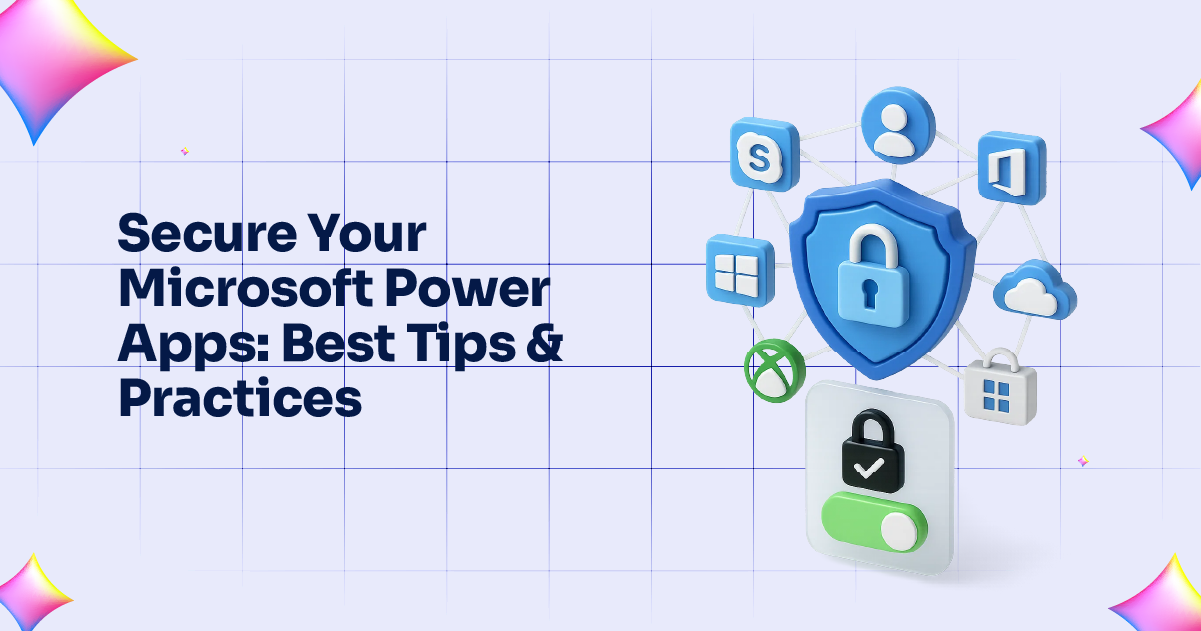
In today’s digital-first world, Microsoft Power Apps has emerged as a powerful tool for businesses to build custom applications with low-code development. These applications streamline processes, enhance productivity, and empower teams to innovate without relying solely on IT departments. However, as with any technology, ensuring data privacy and application security must be a top priority.
With businesses increasingly relying on Microsoft Power Apps for critical operations, it’s essential to understand the best practices for securing your apps against data leaks, unauthorized access, and compliance risks.
In this blog, we’ll explore actionable tips and strategies to safeguard your Power Apps and ensure secure deployment across your organization.
1. Understand the Security Model of Power Apps
Before diving into security measures, it’s important to understand how Power Apps handles security. Microsoft Power Apps uses a layered security model that includes:
- Environment-level security (managed in Power Platform admin center)
- Data source-level security (e.g., permissions in SharePoint, Dataverse, SQL, etc.)
- App-level security (sharing and permissions)
- Connector and API-level security
Each of these layers must be considered when designing your app to avoid weak points in the system.
2. Leverage Role-Based Access Control (RBAC)
Role-Based Access Control (RBAC) allows administrators to define roles and assign permissions based on the principle of least privilege. This ensures users only have access to the data and features necessary for their role.
Best Practice:
Use Azure Active Directory groups to assign roles, and avoid giving full access to everyone. Segregate permissions between users, makers (app creators), and administrators.
3. Secure Data Sources
Many Power Apps applications pull data from external sources like SharePoint, Dataverse, or SQL Server. Each of these has its own security settings, and securing them is critical.
Tips:
- Use Dataverse for more granular control over row-level and column-level security.
- Use parameterized queries and stored procedures for SQL connections to avoid exposing raw queries.
- Regularly audit access permissions to data sources.
4. Enable Multi-Factor Authentication (MFA)
One of the simplest yet most effective ways to secure access to your Power Apps is enabling Multi-Factor Authentication (MFA) for all users accessing the Microsoft 365 environment.
Why it matters:
Even if a user’s password is compromised, MFA adds an extra layer of protection, reducing the risk of unauthorized access.
5. Monitor and Audit Activities
Security is not a one-time task—it requires ongoing monitoring. Power Platform Admin Center and Microsoft 365 Compliance Center offer logging and auditing tools to track changes, access patterns, and suspicious behavior.
Best Practice:
- Regularly review audit logs for anomalies.
- Set up alerts for sensitive data access or unusual login attempts.
- Use Microsoft Defender for Cloud Apps for advanced monitoring.
6. Use Environment Separation
Separating environments—such as Development, Testing, and Production—ensures that incomplete or experimental applications don’t accidentally affect live business operations.
Tips:
- Restrict who can create or deploy apps in production.
- Use Data Loss Prevention (DLP) policies to restrict certain connectors in development environments.
- Regularly back up your production environment.
7. Implement Data Loss Prevention (DLP) Policies
DLP policies help prevent sensitive business data from being shared with unauthorized services. For example, you can create policies that block connectors like Dropbox or Twitter from accessing business data.
Use case example:
You may want to allow Microsoft 365 and SQL Server connectors but block Facebook or other public connectors that pose security risks.
To explore how managed services can help you enforce DLP policies, visit Microsoft Power Apps.
8. Avoid Hardcoding Credentials and Secrets
Never store credentials, API keys, or sensitive configuration details directly within the Power App or in plain text. Instead, use Azure Key Vault or secure connection references.
Why?
Hardcoded secrets can be easily discovered and exploited if the app is shared or reverse-engineered.
9. Review App Sharing Settings
Carefully review who has access to the app. Sharing with “Everyone” or external users without restrictions can expose your data and application logic.
Recommendations:
- Share apps only with specific users or security groups.
- Disable anonymous access.
- Periodically review and revoke access where unnecessary.
10. Train Your Users and Developers
Security awareness is a major defense mechanism. Whether you’re building or using Power Apps, understanding security risks and how to mitigate them is essential.
Conduct training sessions on:
- Secure development practices
- Identifying phishing attempts
- Proper data handling procedures
You can also leverage Microsoft 365 Managed Services from Exinent to streamline administration, ensure compliance, and enhance security across your Power Platform ecosystem.
Conclusion
Power Apps can dramatically enhance your organization’s efficiency and digital agility. But with great power comes great responsibility. By implementing robust security practices—from role-based access control and DLP policies to ongoing monitoring and user training—you can ensure your apps remain safe, compliant, and resilient.
As cyber threats evolve, keeping your Power Apps secure requires a proactive, layered approach. Whether you manage your apps in-house or work with a trusted managed services partner, prioritizing security will protect your data and foster trust in your business solutions.
